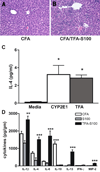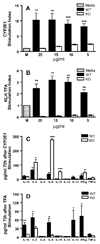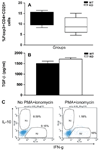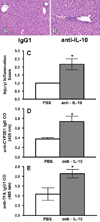Suppressive and pro-inflammatory roles for IL-4 in the pathogenesis of experimental drug-induced liver injury
- PMID: 19499520
- PMCID: PMC2737704
- DOI: 10.1002/eji.200838135
Suppressive and pro-inflammatory roles for IL-4 in the pathogenesis of experimental drug-induced liver injury
Abstract
The pathogenesis of immune-mediated drug-induced liver injury (DILI) following halogenated anesthetics, carbamazepine or alcohol has not been fully elucidated. Detecting cytochrome P450 2E1 (CYP2E1) IgG4 auto-antibodies in anesthetic DILI patients suggests a role for IL-4 in this hapten-mediated process. We investigated IL-4-mediated mechanisms using our model of experimental DILI induced by immunizing BALB/c (WT) and IL-4(-/-) (KO) mice with S100 liver proteins covalently modified by a trifluoroacetyl chloride (TFA) hapten formed following halogenated anesthetic metabolism by CYP2E1. WT mice developed more hepatitis, TFA and S100 antibodies (p<0.01), as well as T-cell proliferation to CYP2E1 and TFA (p<0.01) than KO mice. Additionally, WT CD4(+) T cells adoptively transferred hepatitis to naïve Rag(-/-) mice (p<0.01). Pro-inflammatory cytokines were expectedly decreased in TFA hapten-stimulated KO splenocyte supernatants (p<0.001); however, IL-2 and IFN-gamma (p<0.05), as well as IL-6 and IL-10 (p<0.001) levels were elevated in CYP2E1-stimulated KO splenocyte supernatants, suggesting dual IL-4-mediated pro-inflammatory and regulatory responses. Anti-IL-10 administered to KO mice increased hepatitis, TFA and CYP2E1 antibodies in KO mice confirming a critical role for IL-4. This is the first demonstration of dual roles for IL-4 in the pathogenesis of immune-mediated DILI by suppressing auto-antigen-induced regulatory responses while promoting hapten-induced pro-inflammatory responses.
Conflict of interest statement
None
Figures







Similar articles
-
Suppressive and pro-inflammatory roles for IL-4 in the pathogenesis of experimental drug-induced liver injury: a review.Expert Opin Drug Metab Toxicol. 2010 May;6(5):519-31. doi: 10.1517/17425251003601979. Expert Opin Drug Metab Toxicol. 2010. PMID: 20166853 Free PMC article. Review.
-
IP-10 protects while MIP-2 promotes experimental anesthetic hapten - induced hepatitis.J Autoimmun. 2009 Feb;32(1):52-9. doi: 10.1016/j.jaut.2008.11.003. Epub 2009 Jan 7. J Autoimmun. 2009. PMID: 19131211 Free PMC article.
-
A novel model of drug hapten-induced hepatitis with increased mast cells in the BALB/c mouse.Exp Mol Pathol. 2005 Apr;78(2):87-100. doi: 10.1016/j.yexmp.2004.10.004. Epub 2005 Jan 6. Exp Mol Pathol. 2005. PMID: 15713433
-
In drug-induced, immune-mediated hepatitis, interleukin-33 reduces hepatitis and improves survival independently and as a consequence of FoxP3+ T-cell activity.Cell Mol Immunol. 2019 Aug;16(8):706-717. doi: 10.1038/s41423-018-0087-y. Epub 2018 Jul 20. Cell Mol Immunol. 2019. PMID: 30030493 Free PMC article.
-
Strategies for use of IL-10 or its antagonists in human disease.Immunol Rev. 2008 Jun;223:114-31. doi: 10.1111/j.1600-065X.2008.00635.x. Immunol Rev. 2008. PMID: 18613832 Review.
Cited by
-
Hepatoprotective Effects of Rosmarinic Acid on Ovalbumin-Induced Intestinal Food Allergy Mouse Model.Molecules. 2023 Jan 12;28(2):788. doi: 10.3390/molecules28020788. Molecules. 2023. PMID: 36677846 Free PMC article.
-
Suppressive and pro-inflammatory roles for IL-4 in the pathogenesis of experimental drug-induced liver injury: a review.Expert Opin Drug Metab Toxicol. 2010 May;6(5):519-31. doi: 10.1517/17425251003601979. Expert Opin Drug Metab Toxicol. 2010. PMID: 20166853 Free PMC article. Review.
-
Soluble CD46 as a diagnostic marker of hepatic steatosis.EBioMedicine. 2024 Jun;104:105184. doi: 10.1016/j.ebiom.2024.105184. Epub 2024 Jun 4. EBioMedicine. 2024. PMID: 38838471 Free PMC article.
-
Identification of a Shared Cytochrome p4502E1 Epitope Found in Anesthetic Drug-Induced and Viral Hepatitis.mSphere. 2018 Oct 10;3(5):e00453-18. doi: 10.1128/mSphere.00453-18. mSphere. 2018. PMID: 30305319 Free PMC article.
-
Drug-induced hepatotoxicity: metabolic, genetic and immunological basis.Int J Mol Sci. 2014 Apr 22;15(4):6990-7003. doi: 10.3390/ijms15046990. Int J Mol Sci. 2014. PMID: 24758937 Free PMC article. Review.
References
-
- Schiodt FV, Atillasoy E, Shakil AO, Schiff ER, Caldwell C, Kowdley KV, Stribling R, Crippin JS, Flamm S, Somberg KA, Rosen H, McCashland TM, Hay JE, Lee WM. Etiology and outcome for 295 patients with acute liver failure in the United States. Liver Transpl.Surg. 1999;5:29–34. - PubMed
-
- Ostapowicz G, Fontana RJ, Schiodt FV, Larson A, Davern TJ, Han SH, McCashland TM, Shakil AO, Hay JE, Hynan L, Crippin JS, Blei AT, Samuel G, Reisch J, Lee WM. Results of a prospective study of acute liver failure at 17 tertiary care centers in the United States. Ann.Intern.Med. 2002;137:947–954. - PubMed
-
- Masubuchi Y, Bourdi M, Reilly TP, Graf ML, George JW, Pohl LR. Role of interleukin-6 in hepatic heat shock protein expression and protection against acetaminophen-induced liver disease. Biochem.Biophys.Res.Commun. 2003;304:207–212. - PubMed
-
- Castell JV. Allergic hepatitis: a drug-mediated organ-specific immune reaction. Clin.Exp.Allergy. 1998;28(Suppl 4):13–19. 13-9. - PubMed
-
- Adkinson NF, Jr, Essayan D, Gruchalla R, Haggerty H, Kawabata T, Sandler JD, Updyke L, Shear NH, Wierda D. Task force report: future research needs for the prevention and management of immune-mediated drug hypersensitivity reactions. J.Allergy Clin.Immunol. 2002;109:S461–S478. - PubMed
Publication types
MeSH terms
Substances
Grants and funding
LinkOut - more resources
Full Text Sources
Medical
Molecular Biology Databases
Research Materials

